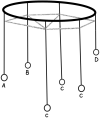Analog Resonance Computation: A New Model for Human Cognition
- PMID: 33013530
- PMCID: PMC7509107
- DOI: 10.3389/fpsyg.2020.02080
Analog Resonance Computation: A New Model for Human Cognition
Abstract
Early models of human cognition appeared to posit the brain as a collection of discrete digital computing modules with specific data processing functions. More recent theories such as the Hierarchically Mechanistic Mind characterize the brain as a massive hierarchy of interconnected and adaptive circuits whose primary aim is to reduce entropy. However, studies in high workload/stress situations show that human behavior is often error prone and seemingly irrational. Rather than regarding such behavior to be uncharacteristic, this paper suggest that such "atypical" behavior provides the best information on which to base theories of human cognition. Rather than using a digital paradigm, human cognition should be seen as an analog computer based on resonating circuits whose primary driver is to constantly extract information from the massively complex and rapidly changing world around us to construct an internal model of reality that allows us to rapidly respond to the threats and opportunities.
Keywords: behavior; cognition; decision making; human error; learning.
Copyright © 2020 Byrne.
Figures
Similar articles
-
Computation for cognitive science: Analog versus digital.Wiley Interdiscip Rev Cogn Sci. 2024 Jul-Aug;15(4):e1679. doi: 10.1002/wcs.1679. Epub 2024 Apr 24. Wiley Interdiscip Rev Cogn Sci. 2024. PMID: 38655784 Review.
-
Subject-Specific Cognitive Workload Classification Using EEG-Based Functional Connectivity and Deep Learning.Sensors (Basel). 2021 Oct 9;21(20):6710. doi: 10.3390/s21206710. Sensors (Basel). 2021. PMID: 34695921 Free PMC article.
-
Scalable hybrid computation with spikes.Neural Comput. 2002 Sep;14(9):2003-38. doi: 10.1162/089976602320263971. Neural Comput. 2002. PMID: 12184840
-
Neural computation and the computational theory of cognition.Cogn Sci. 2013 Apr;37(3):453-88. doi: 10.1111/cogs.12012. Epub 2012 Nov 5. Cogn Sci. 2013. PMID: 23126542
-
The computational power of the human brain.Front Cell Neurosci. 2023 Aug 7;17:1220030. doi: 10.3389/fncel.2023.1220030. eCollection 2023. Front Cell Neurosci. 2023. PMID: 37608987 Free PMC article. Review.
References
LinkOut - more resources
Full Text Sources


